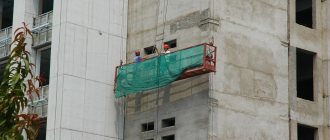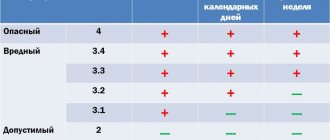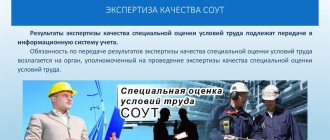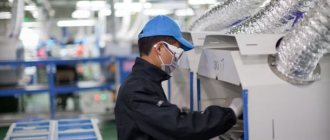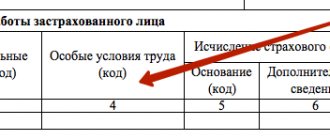The conditions in which a worker finds himself can have an impact on his health. It is important to know whether a certain profession affects the life and health of an employee. If the harmfulness does not exceed the permissible norm of negative impact on the employee’s body, then such conditions can be considered harmless
Many factors can have a negative impact on an employee's health. If the environment or work process is harmful and unfavorable, it can cause a number of negative consequences for the employee.
These consequences include: exacerbation of chronic diseases, the emergence of new diseases, negative changes in the psyche, complete or partial loss of ability to work. In order for the employee to clearly understand what working conditions he will have to deal with and what the consequences may be, a special classification of working conditions was introduced according to the degree of its harmfulness.
Degree of harmful working conditions
What are hazardous working conditions?
There are such degrees of harmfulness of work:
- first degree of harm.
Unfavorable factors in the work environment can cause a number of negative health changes that disappear if the employee breaks off contact with them for a long time;
- second degree.
Significant changes occur in the functioning of an employee’s body due to the influence of various factors during work. They concern mainly those organs that suffer most from this type of activity. The employee may temporarily lose his ability to work. It is restored some time after the cessation of work;
- third degree.
An employee suffers from an occupational illness. Their severity can be mild or moderate. The employee loses professional ability to work while performing his work;
- fourth degree.
Working in such conditions can lead to the occurrence of serious illnesses. They can be chronic. The employee loses the ability to work in any field.
Mandatory special assessment
Certification of workplaces or special assessment of working conditions
Important! Carrying out a special assessment of working conditions is mandatory for any enterprise or organization. This is stated in Federal Law 426 and the Labor Code of the Russian Federation (Article 212).
SOUT is carried out in several stages. At the first stage, the organization of the process and preparation for it are carried out. Then comes the process of identifying potentially harmful and dangerous factors during production, and also the process of measuring them. Next, all factors of the production environment and the work process are identified, and the research results are compiled.
In order to correctly calculate the value of the indicators, as well as determine what additional payments and benefits will be provided by the SOUT for hazard classes, it is necessary to create a special commission. It should consist of enterprise specialists and experts from licensing organizations. The commission checks working conditions, measures all the necessary parameters and establishes the degree of deviation of the measurements from the developed standards. Based on the results of the inspection, a conclusion is created, which indicates the assigned class of working conditions.
Mandatory SOUT
Harmful working conditions by class
List of hazard classes.
- First grade. Conditions are optimal. This category includes workplaces where there are no factors that threaten the life and health of employees. This is a completely safe job;
- second class. The potential for harm to employee health is negligible. Recovery of the body should occur by the beginning of the next working day;
- third class. Working conditions are harmful to employee health. The effect of adverse factors on employee health is significant. The third class of production hazards is divided into four subgroups:
- The first subgroup of harmful working conditions of the third class. The employee’s body is exposed to the harmful effects of working environment factors. Normalization of all body systems does not have time to occur before the start of the next work shift. The health risk is significant.
- Second subgroup. Persistent changes in the employee’s health status begin. They cause moderate harm and can cause various diseases. The employee completely or partially loses his ability to work after fifteen or more years of work in such conditions.
- Third subgroup. Mild to moderate illnesses may occur while performing work duties. The effect of negative factors on the body is persistent and destructive.
- Fourth subgroup. Assumes a threat to the life and health of the employee, loss of ability to work in a given professional field;
- fourth grade. Dangerous working conditions. The employee’s work activity poses a danger to life and health.
In such conditions, chronic diseases may worsen. Serious occupational illnesses appear.
Occupational Safety and Health
Classes of working conditions according to the degree of harmfulness and danger of factors in the working environment and the labor process
Any type of professional activity in order to achieve ultimate goals should optimally be accompanied by the highest productivity and labor efficiency in the absence of signs of impairment to the health of workers.
Ensuring these conditions is based on scientifically developed hygienic standards, according to which working conditions are divided into classes according to the degree of harmfulness and danger. Hygienic criteria are indicators that characterize the degree of deviation of the parameters of working environment factors and the labor process from current hygienic standards. The classification of working conditions, developed by the Research Institute of Occupational Medicine of the Russian Academy of Medical Sciences, is based on the principle of differentiation of these deviations, which give the right to assign working conditions to a certain class of hazards for potential danger (“Hygienic criteria for assessing working conditions in terms of the harmfulness and danger of factors in the working environment, the severity and intensity of labor process" (R.2.2.755-99 dated April 23, 1999; ADZ RK No. 1.04.001.2000).
Based on the degree of deviation of the actual levels of working environment factors and the labor process from hygienic standards, working conditions according to the degree of harmfulness and danger are conventionally divided into 4 classes: optimal, acceptable, harmful and dangerous.
Optimal working conditions (class 1) are conditions under which the employee’s health is maintained and the prerequisites are created for maintaining a high level of performance. Optimal standards for working environment factors have been established for microclimatic parameters and workload factors. For other factors, working conditions in which there are no harmful factors or do not exceed levels accepted as safe for the population are conventionally accepted as optimal.
Acceptable working conditions (class 2) are characterized by such levels of environmental factors and the labor process that do not exceed established hygienic standards for workplaces, and possible changes in the functional state of the body are restored during regulated rest or by the beginning of the next shift and do not have an adverse effect in the immediate and future. in the long term on the health of workers and their offspring. Acceptable working conditions are conditionally classified as safe.
Harmful working conditions (class 3) are characterized by the presence of harmful factors, the levels of which exceed hygienic standards and have an adverse effect on the worker’s body and (or) his offspring.
Harmful working conditions, based on the degree of exceeding hygienic standards and the severity of changes in the body of workers, are conventionally divided into 4 degrees of harmfulness:
1st degree, 3rd class (3.1) - working conditions are characterized by such deviations in the levels of harmful factors from hygienic standards that cause functional changes, which are restored, as a rule, with a longer interruption of contact with harmful factors (than at the beginning of the next shift) and increase the risk of damage to health ;
2 degree 3 class (3.2) - levels of harmful factors that cause persistent functional changes, leading in most cases to an increase in occupational morbidity (which can be manifested by an increase in the level of morbidity with temporary disability and, first of all, those diseases that reflect the condition of the most organs and systems vulnerable to these factors), the appearance of initial signs or mild forms of occupational diseases (without loss of professional ability) that arise after prolonged exposure (often after 15 years or more);
3rd degree 3rd class (3.3) - working conditions characterized by such levels of working environment factors, the impact of which leads to the development, as a rule, of occupational diseases of mild and moderate severity (with loss of professional ability to work) during the period of working activity, the growth of chronic (occupationally caused ) pathology;
4th degree, 3rd class (3.4) - working conditions under which severe forms of occupational diseases can occur (with loss of general ability to work), there is a significant increase in the number of chronic diseases and high levels of morbidity with temporary loss of ability to work.
Hazardous (extreme) working conditions (class 4) are characterized by levels of working environment factors, the impact of which during a work shift (or part of it) creates a threat to life, a high risk of developing acute occupational injuries, incl. severe forms.
Tables No. 50-62 present classes of working conditions depending on the content of producing microorganisms, chemicals and physical factors, aerosols in the air of the working area; a classification of working conditions according to microclimate indicators, light environment parameters, exposure to non-ionizing electromagnetic radiation and a classification of working conditions according to indicators of severity and intensity of the labor process are also presented.
Table No. 50. Classes of working conditions depending on the content of harmful substances of a chemical nature in the air of the working area (exceeding the maximum permissible concentration, times)
| Harmful substances | Class of working conditions | |||||
| Acceptable | Harmful | Dangerous | ||||
| 2 | 3.1 | 3.2 | 3.3 | 3.4 | 4 | |
| Harmful substances of hazard class 1-2, with the exception of those listed below | < MPC | 1,1-3,0 | 3,1-6,0 | 6,1-10,0 | 10,1-20,0 | > 20,0 |
| Harmful substances of hazard class 3-4, with the exception of those listed below | < MPC | 1,1-3,0 | 3,1-10,0 | > 10,0 | ||
| Substances dangerous for the development of acute poisoning: with a highly targeted mechanism of action, irritant action | < MPC | 1,1-2,0 | 2,1-4,0 | 4,1-6,0 | 6,1-10,0 | > 10,0 |
| Carcinogens | < MPC | 1,1-3,0 | 3,1-6,0 | 6,1-10,0 | > 10,0 | |
| Allergens | < MPC | 1,1-3,0 | 3,1-10,0 | > 10,0 | ||
| Antitumor drugs, hormones (estrogens) | < MPC | + | ||||
| Narcotic analgesics | < MPC | + | ||||
Table No. 51. Classes of working conditions depending on the content of producing microorganisms in the air of the working area
| Harmful substances | Class of working conditions | ||||||
| Acceptable Harmful | Dangerous | ||||||
| 2 3.1 3.2 3.3 | 3.4 | 4 | |||||
| Producing microorganisms, preparations containing living cells and spores of microorganisms | < MPC | 1,1-3,0 | 3,1-10,0 | > 10,0 | |||
| Pathogenic microorganisms | Particularly dangerous infections | + | |||||
| Pathogens of others infectious diseases | + | ||||||
Table No. 52. Classes of working conditions depending on the content in the air of the working area of aerosols of predominantly fibrogenic action (APFA) and dust loads on the respiratory system (multiplicity of excess of MPC and CPN)
| Harmful substances | Class of working conditions | |||||
| Acceptable | Harmful | Dangerous (extreme) | ||||
| 2 | 3.1 3.2 3.3 3.4 | 4 | ||||
| Exceeding MPC, times | ||||||
| Dust concentration < MPC 1.1-2.0 2.1-5.0 5.1-10.0 > 10.0 | ||||||
| Exceeding the CIT, times | ||||||
| Dust load (LO) < CLP 1.1-2.0 2.1-5.0 5.1-10.0 > 10.0 | ||||||
| Dust load for dusts with a pronounced fibrogenic effect (MPC < 1 mg/m3), as well as for asbestos-containing dusts | < CIT | 1,1-1,5 | 1,6-3,0 | 3,1-5,0 | > 5,0 | |
Table No. 53. Classes of working conditions depending on noise levels, local and general vibration, infra- and ultrasound in the workplace
| Index | Class of working conditions | |||||
| Acceptable | Harmful | Dangerous (extreme) | ||||
| 2 | 3.1 3.2 3.3 3.4 | 4 | ||||
| Exceeding the maximum limit up to... | ||||||
| Noise Equivalent sound level, dBA | < remote control | 5 | 15 | 25 | 35 | > 35 |
| Local vibration Equivalent adjusted vibration velocity level, dB | < remote control | 3 | 6 | 9 | 12 | > 12 |
| General vibration Equivalent adjusted vibration velocity level, dB | < remote control | 6 | 12 | 18 | 24 | > 24 |
| Infrasound Overall sound pressure level, dB Lin | < remote control | 5 | 10 | 15 | 20 | > 20 |
| Ultrasound air Sound pressure levels in 1/3 octave frequency bands, dB | < remote control | 10 | 20 | 30 | 40 | > 40 |
| Ultrasound contact Vibration velocity level, dB | < remote control | 5 | 10 | 15 | 20 | > 20 |
Table No. 54. Classes of working conditions according to microclimate indicators for industrial premises, regardless of periods of the year and open areas during the warm period of the year
| Index | Class of working conditions | |||
| Optimal | Acceptable | Harmful | Dangerous (extreme) | |
| 1 | 2 | 3.1 3.2 3.3 3.4 | 4 | |
| Air temperature, оС | according to SanPiN | according to SanPiN | according to the TNS index (see table No. 55); by air temperature for rooms with a cooling microclimate (see table No. 56) | |
| Air speed, m/s | according to SanPiN | according to SanPiN | taken into account in the TNS index (see Table No. 55); when assessing the cooling microclimate, it is taken into account as a temperature correction (see table No. 56) | |
| Air humidity, % | according to SanPiN | according to SanPiN | according to the TNS index (see table No. 55) or | |
| 14-10 < 10 | ||||
| THC index, °C | according to table No. 55 | |||
| Thermal irradiation, W/m2 | according to SanPiN | according to SanPiN | 1 001-1 500 1 501-2 000 2 001-2 500 2 501-2 800 | > 2 800 |
Table No. 55. Classes of working conditions according to the THC index (°C) for industrial premises with a heating microclimate, regardless of the period of the year and open areas during the warm period of the year
| Class of working conditions | ||||||||
| Category of work | Are common | Harmful | Dangerous (extreme) | |||||
| energy consumption, W/m2 | Optimal | Acceptable | 1 degrees | 2 degrees | 3 degrees | 4 degrees | ||
| 1 | 2 | 3.1 | 3.2 | 3.3 | 3.4 | 4 | ||
| I a | 68 (58-77) | 22,2-26,4 | 26,5-26,6 | 26,7-27,4 | 27,5-28,6 | 28,7-31,0 | > 31,0 | |
| I b | 88 (78-97) | 21,5-25,8 | 25,9-26,1 | 26,2-26,9 | 27,0-27,9 | 28,0-30,3 | > 30,3 | |
| II a | 113 (98-129) | 20,5-25,8 | 25,2-25,5 | 25,6-26,2 | 26,3-27,3 | 27,4-29,9 | 29,9 | |
| II b | 145 (13°-16°) | 19,5-23,9 | 24,0-24,2 | 24,3-25,0 | 25,1-26,4 | 26,5-29,1 | > 29,1 | |
| III | 177 | 18,°-21,8 | 21,9-22,2 | 22,3-23,4 | 23,5-25,7 | 25,8-27,9 | > 27,9 | |
Table No. 56. Classes of working conditions according to air temperature (°C, lower limit) when working in industrial premises with a cooling microclimate
| Category of work | Total energy consumption, W/m2 | Class of working conditions | ||||||
| Optimal | Acceptable | Harmful | Dangerous (extreme) | |||||
| 1 degrees | 2 degrees | 3 degrees | 4 degrees | |||||
| 1 | 2 | 3.1 | 3.2 | 3.3 | 3.4 | 4 | ||
| I a | 68 (58-77) | according to SanPiN | according to SanPiN | 18 | 16 | 14 | 12 | |
| I b | 88 (78-97) | according to SanPiN | according to SanPiN | 17 | 15 | 13 | 11 | |
| II a | 113 (98-129) | according to SanPiN | according to SanPiN | 14 | 12 | 10 | 8 | |
| II b | 145 (13°-16°) | according to SanPiN | according to SanPiN | 13 | 11 | 9 | 7 | |
| III | 177 | according to SanPiN | according to SanPiN | 12 | 1° | 8 | 6 | |
Table No. 57. Classes of working conditions according to air temperature (°C, lower limit) for open areas during the cold season and in cold (unheated) rooms
| Climate zone | Thermal insulation of clothing | Class of working conditions | |||||
| Acceptable | Harmful | Dangerous (extreme) | |||||
| 1 degrees | 2 degrees | 3 degrees | 4 degrees | ||||
| 2 | 3.1 | 3.2 | 3.3 | 3.4 | 4 | ||
| I A | 0,71 | -30 | -36 | -38,5 | -40,8 | -60 | < -60,0 |
| I B | 0,82 | -38 | -46,2 | -48,9 | -54,4 | -70 | < -70,0 |
| II | 0,61 | -23 | -29,4 | -31,5 | -35,7 | -48 | < -48,0 |
| III | 0,51 | -15,9 | -21,3 | -23 | -28 | -37 | < -37,0 |
Table No. 58. Classes of working conditions depending on the parameters of the light environment of production premises
| Factor, indicator | Class of working conditions | |||||
| Acceptable | Harmful - 3 | |||||
| 1st degree | 2 degrees | 3 degrees | 4 degrees | |||
| 2 | 3.1 | 3.2 | 3.3 | 3.4 | ||
| Daylight: Natural light coefficient (KEO, %) | > 0,6 | 0,1-0,6 | < 0,1 | |||
| Artificial lighting: | ||||||
| Illumination of the working surface (E, Lux) for categories of visual work: | I-IV, VII | Yong | 0.5 En < En | <0.5 En | ||
| V, VI, VIII-XIV | Yong | < En | ||||
| Blindness index (P, relative units) | Rn | > Rn | ||||
| Reflected gloss | absence | Availability | ||||
| Illumination pulsation coefficient (Cl, %) | Cln | >Cln | ||||
| Brightness (L, cd/m2) | Lн | > Lн | ||||
| Uneven brightness distribution (C, rel. units) | Sn | > Sn | ||||
Table No. 59. Classes of working conditions under the influence of non-ionizing electromagnetic radiation (electromagnetic fields and radiation)
| Factor | Class of working conditions | ||||||
| Optimal | Acceptable | Harmful | Dangerous (extreme) | ||||
| 1 degrees | 2 degrees | 3 degrees | 4 degrees | ||||
| 1 | 2 | 3.1 | 3.2 | 3.3 | 3.4 | 4 | |
| 1 | 2 | 3 | 4 | 5 | 6 | 7 | 8 |
| Exceeding the maximum limit (times) | |||||||
| Geomagnetic field | natural background | < vdu | < 5 | < 10 | < 50 | > 50 | |
| Electrostatic field | natural background | < remote control | < 3 | < 5 | < 10 | > 10 | |
| Constant magnetic field | natural background | < remote control | < 5 | < 10 | < 10 | > 10 | |
| Electric fields of industrial frequency (5° Hz) | natural background | < remote control | < 5 | < 10 | < 50 | > 50 | > 40 |
| Power frequency magnetic fields (5° Hz) | natural background | < remote control | < 5 | < 10 | < 50 | > 50 | |
| EMR generated by VDTs and PCs | < remote control | < 5 | < 10 | < 50 | > 50 | ||
| Radio frequency EMR: | |||||||
| 0.01-0.03 MHz | natural background | < remote control | < 3 | < 5 | < 10 | > 10 | |
| 0.03-3.0 MHz | natural background | < remote control | < 3 | < 5 | < 10 | > 10 | |
| 3.0-30.0 MHz | natural background | < remote control | < 3 | < 5 | < 10 | > 10 | |
| 30.0-300.0 MHz | natural background | < remote control | < 3 | < 5 | < 10 | > 10 | > 50 |
| 300.0-MHz-300.0 GHz | natural background | < remote control | < 3 | < 5 | < 10 | > 10 | > 50 |
Table No. 60. Classes of working conditions under the influence of non-ionizing electromagnetic radiation of the optical range (laser, ultraviolet)
Table No. 61. Classes of working conditions according to indicators of the severity of the labor process
Table No. 62. Classes of working conditions according to indicators of intensity of the labor process
Benefits for hazardous working conditions
Employees are entitled to benefits.
Those factors that affect employees of an enterprise during work often have an adverse effect on the body, disrupting its proper functioning. Sometimes unfavorable conditions in the workplace can threaten not only the health, but also the life of the employee.
Therefore, every employee who performs his or her job duties in hazardous conditions is entitled to benefits. They are calculated by the accounting department. The size and form of benefits are determined depending on the class and degree of harmfulness of working conditions.
Benefits that are due for working in hazardous conditions: timely pension on special conditions, provision of milk and other products to employees, changes in working hours, monetary compensation.
For example, a normal work week is 40 hours. If hazardous working conditions exist, the work week is reduced to 36 hours.
Labor legislation allows a significant reduction in hours in the presence of exposure to harmful factors.
If the working week is 36 hours long, one shift can last no more than 8 hours. If the work week is 30 hours, then the shift can last no more than 6 hours.
How to reduce the occupational hazard class
If workers employed in workplaces with hazardous working conditions use properly certified personal protective equipment of sufficient effectiveness, the class (subclass) of working conditions may be lowered by a special commission, based on the conclusion of an expert from the organization that conducts the special assessment, by one degree.
In accordance with the decision of the territorial branch of the executive authority responsible for sanitary and epidemiological supervision, at the location of the relevant workplaces, it is possible to reduce the class (subclass) of working conditions by more than one degree.
Regarding jobs at enterprises engaged in certain types of activities, a reduction in the class (subclass) of working conditions can be carried out in accordance with the characteristics of the industry.
Documents for providing employees with guarantees under the Labor Code of the Russian Federation
In order for employees to receive guarantees and compensation, management must draw up certain documents. The development of these labor protection documents is entrusted to the relevant department or outsourced.
- Employees are informed of the results of the special assessment against signature within 1 calendar month from the date of approval of the report on the special assessment.
- Management issues an order to the organization regarding the appointment of wage increases, the provision of additional paid leave and other guarantees.
- The parties make changes to employment contracts. They describe working conditions in the workplace, specify guarantees and compensation for harmful (dangerous) working conditions.
To adjust the contract, you should prepare notifications about adjusting the terms of the employment contract. They provide information to employees about whether conditions in their workplaces have been determined to be hazardous or hazardous. In addition, the notice must indicate the guarantees and compensation due in connection with this.
An additional agreement is concluded with employees who agree to continue their employment relationship with the employer under the new conditions. If an employee decides not to continue working in harmful conditions, the employer is forced to terminate his employment contract, having previously offered him to move to an alternative vacant position (see Article 74 of the Labor Code of the Russian Federation).
The former is obliged to notify the latter in writing of the planned changes to the terms of the employment agreement approved by the employer and the employee, as well as the reasons that caused the changes, at least two months before the implementation of these changes.
The employer has the right to change the terms of the employment contract in the following cases:
- during the transformation of the technological base of production,
- when reorganizing the structure of the enterprise,
- with other transformations of production organization and technology.
Important! Employees who do not agree to continue working in conditions recognized as harmful are paid an increased salary and are provided with other work-related guarantees for two months (this is how long the notice period before dismissal lasts).
Registration of results
Frequency of special assessment of working conditions
According to the order of the Ministry of Labor No. 33, SOUT is provided in a strictly defined form. To do this, a report is generated that contains information about the organization, information about the appraiser, a list of jobs, classifications of working conditions after carrying out the special labor assessment.
The process is carried out only by a special person who has an expert license
A specialist visits the organization and evaluates only harmful factors. Aesthetics don't bother him. Therefore, it takes into account lighting, its quantity, noise, dust, etc. The color of the walls and doorway is not important to the expert.
A report on small organizations contains information about the conditions in which people work. Therefore, offices, workshops, canteens and other places are subject to inspection.
Who does not need to carry out SOUT:
- companies with one employee who works from home;
- companies without an office, where all employees are freelancers;
- private workers. For example, housekeepers or nannies in the family.
The entire SOUT process can be divided into three stages: selecting a contractor and collecting documents, checking and receiving a report, submitting a declaration and informing employees.
The expert must be accredited by the Ministry of Labor. The cost of SOUT depends on a number of factors. The smaller the size of the enterprise, the higher the price. The remoteness of the location and complexity also have an impact (for example, in some workshops it is necessary to measure the noise level).
Before conducting an inspection, the general director needs to issue an order that will reflect the composition of the commission. It must include an odd number of participants. The paper indicates the date of the SOUT and the inspection schedule.
Important! Additionally, a list of places that will be assessed is made.
The order, list and schedule remain with the company’s accountant. All documents must be approved through the General Director. He puts a stamp and signature.
The report should contain several important points. The first is complete information about the organization, a list of workplaces, measurement and research protocols. Any checks must be carried out using special tools. For example, lighting is checked with a lux meter.
Additionally, copies of accreditation documents (if available) are attached.
The report includes special assessment maps. An important part is a summary statement of the results of a special assessment of working conditions. The tables indicate all positions and the assigned labor class with the required benefits.
If necessary, recommendations should be made to improve working conditions. For example, purchasing additional lamps or comfortable furniture.
Assessment of production conditions
To determine the class of hazards present in the workplace, a commission is created, including experts from licensed companies. Based on the results of the inspection and measurements taken, the degree of deviation of existing indicators from the established standards is established. Thus, a conclusion is made on assigning a certain hazard class to the working conditions. More information about conducting a special assessment of working conditions can be read at https://otdelkadrov.online/11668-poryadok-provedeniya-spetsialnoi-otsenki-uslovii-truda-sout-na-predpriyatiyah.
Preparation for a special assessment of working conditions
A commission is convened and an order is created.
In order to competently, without missing the nuances required by law, carry out the SOUT, you need to follow the following sequence:
- create an internal commission of 3 people, approve it by Order of the company.
The commission includes:
- Head, with the rights of chairman;
- Occupational safety specialist;
- Representative from the trade union (if it is organized);
- Other specialists (HR officer, chief engineer, lawyer, etc.) so that the total number of participants is odd.
There are options when, for one reason or another, the organization does not have a labor protection specialist on staff, and his responsibilities are assigned to a third-party company under a contract. Then the commission should include a responsible person from this company;
- by the decision of the commission to approve the list of jobs.
Workplaces that have equal job functions and similar microclimate and lighting parameters, located in the same or similar premises, equipped with appropriate protective equipment, where similar equipment is used, are similar. When such places exist, they need to be displayed in the approved list;
- contact a company approved to provide special assessment services.
The simplest option for checking the legal capacity of a potential service provider is to check his presence in the list of the Ministry of Labor available on its website.
The law allows you to reduce the cost of the contract by including in the list at least 20% of the evaluated jobs for each type of similar place, which is very attractive for enterprises with a large number of personnel.
Naturally, the service provider has the right to verify the reliability and legality of grouping similar places before starting work.
How to retire early
For everyone who managed to work in such institutions, there is a way to retire earlier than the standard 55 and 60 years, respectively.
There are several steps you need to follow:
- check on the Pension Fund website or with a pension fund specialist how many years of experience are required for a specific position and the minimum age at which you can quit;
- work until the required 47-50-53 years, depending on the specialty;
- Upon reaching the required number of years, take supporting documents from work and contact the Pension Fund for registration.
It is worth noting that you must have the appropriate number of points. The Pension Fund will also tell you about this when you apply. You can read more on the foundation's website.
